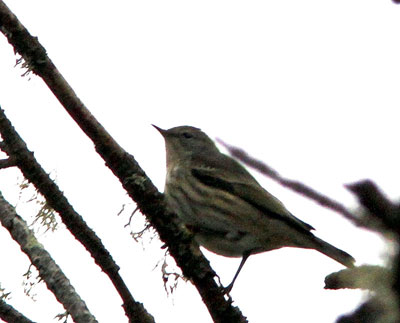Lake Merced, San Francisco, San Francisco County, CA
14 September 2011
Joseph Morlan
Photos © 14 September by Linda Swanson. All rights reserved.

Cape May Warbler (Setophaga tigrina)
Lake Merced, San Francisco, San Francisco County, CA
14 September 2011
Joseph Morlan
Photos © 14 September by Linda Swanson. All rights reserved. 
After learning that the Cape May Warbler found this morning by Dominik Mosur was still present at Lake Merced until at least 1 PM, I decided to meet Robbie Fischer there late this afternoon. A Chestnut-sided Warbler, Tennessee Warbler and Blackpoll Warbler had also been reported in the same area. I arrived around 4 PM and we spent the better part of an hour before we located a Yellow Warbler, then the immature. Chestnut-sided Warbler and then the dull female Cape May. I pointed out these birds to Richard Drechsler. We had several good looks at the Cape May, once with both the Chestnut-sided and the Cape May in the same binocular view. Soon other birders arrived. We relocated the Cape May two more times. Paul Saraceni saw it at least one of those times. Others arriving after 5:30 PM did not see the Cape May, although the Chestnut-sided continued to show well (Calvin Lou's photo).
All sightings were in the trees at the southeast end of Lake Merced and just west of the Bufano statue of a
penguin It was not photographed during the time we had it under observation, but Linda Swanson obtained these photos
earlier today. A larger version
of one photo is on the WFO web site. 
Description
The following description is based on memory and on photos:
A small warbler looking rather like a drab Yellow-rumped Warbler but with a shorter, more finely tipped bill and much shorter tail. The upperparts were gray including most of the head and face. The dark eye had a faint eye-ring broken front and back by a thin line extending from the base of the bill back across the top of the gray ear coverts. The underparts were off-white with a creamy tinge in some lights. The pale throat contrasted with the gray ear coverts and extended up onto the side of the neck forming a slight wrap around the lower border of the ear coverts. This pattern recalled "Myrtle" Warbler. The rest of the underparts were quite boldly streaked from the chest to the flanks, with streaking across the breast fading to an unstreaked area on the belly. Overall, the underpart pattern reminded me of a Pine Siskin. The wings showed no obvious wing-bars, but photos reveal pale tips to the median coverts and pale fringes to the greater coverts. The tertials were fringed with pale gray while the primaries and secondaries were fringed with yellowish. The primary coverts and alula were black. Feet and legs were black.
I listened for the chip note, but did not hear it. However, this area was quite noisy and I'm not sure I could have heard the call.
Discussion
This species was added to the CBRC review list at the January 2011 meeting based on the paucity of California records in recent years. From approximately 1968 until 1980 there were 121 records; from 1980-1995 there were 88 records; from 1996-2009 there were 41 records. The downward trend is evident. During the period from 2000-2009 there was an average of 3.3 records per year, well below the four records per year guideline for CBRC review. A decline in outbreaks of Spruce Budworm in recent decades is believed to be the cause of this decline (Patten and Burger 1998).
This species was formerly included in the genus Dendroica. It was merged with Setophaga in the 52nd Supplement to the AOU Checklist. (The Auk 128:600-613, 2011). [PDF]
Reference
Patten, M.A., and Burger, J.C. 1998. Spruce Budworm outbreaks and the incidence of vagrancy in eastern North American wood warblers. Can. J. Zool. 76:433-439. [PDF]